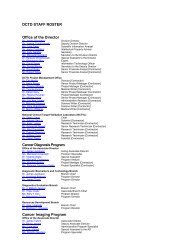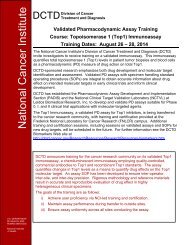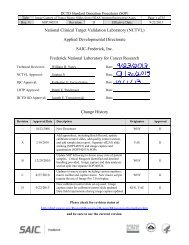National Cancer Institute - NCI Division of Cancer Treatment and ...
National Cancer Institute - NCI Division of Cancer Treatment and ...
National Cancer Institute - NCI Division of Cancer Treatment and ...
You also want an ePaper? Increase the reach of your titles
YUMPU automatically turns print PDFs into web optimized ePapers that Google loves.
B I O M E T R I C R E S E A R C H B R A N C H<br />
Accomplishing research in the areas <strong>of</strong> statistical, mathematical,<br />
<strong>and</strong> computational sciences that is motivated <strong>and</strong> informed by<br />
real <strong>and</strong> important problems <strong>of</strong> current cancer research is the<br />
goal <strong>of</strong> the Biometric Research Branch.<br />
The Biometric Research Branch<br />
(BRB) is the statistical <strong>and</strong> biomathematical<br />
component <strong>of</strong> the <strong>Division</strong><br />
<strong>of</strong> <strong>Cancer</strong> <strong>Treatment</strong> <strong>and</strong> Diagnosis<br />
(DCTD). BRB members provide statistical<br />
leadership for DCTD national research<br />
programs in clinical trials, developmental<br />
therapeutics, developmental diagnostics,<br />
diagnostic imaging, <strong>and</strong> statistical <strong>and</strong><br />
computational genomics. During 2005, BRB<br />
consisted <strong>of</strong> 13 permanent doctoral-level<br />
research investigators supplemented by<br />
postdoctoral research fellows <strong>and</strong> guest<br />
researchers. Staff members have doctoral<br />
degrees <strong>and</strong> expertise in biostatistics,<br />
biomathematics, computational biology,<br />
<strong>and</strong> computer science.<br />
The philosophy <strong>of</strong> BRB is to have the staff<br />
combine two functions: (1) collaboration<br />
<strong>and</strong> consultation with scientific administrators<br />
at DCTD <strong>and</strong> intramural investigators<br />
at the <strong>National</strong> <strong>Cancer</strong> <strong>Institute</strong><br />
(<strong>NCI</strong>); (2) conduct <strong>of</strong> self-initiated research<br />
on topics important to cancer research<br />
<strong>and</strong> to the collaborative investigations.<br />
Combining these functions has enabled<br />
BRB to recruit <strong>and</strong> retain a very highquality<br />
research staff, to provide the highest<br />
quality collaborative <strong>and</strong> consulting<br />
staff to DCTD <strong>and</strong> <strong>NCI</strong> scientists, <strong>and</strong> to<br />
accomplish research in the areas <strong>of</strong> statistical,<br />
mathematical, <strong>and</strong> computational<br />
sciences that is motivated <strong>and</strong> informed<br />
by real <strong>and</strong> important problems <strong>of</strong> current<br />
cancer research. BRB does not have a<br />
O V E R V I E W<br />
grant, cooperative agreement, or contract<br />
portfolio <strong>and</strong> does not sponsor or fund<br />
extramural research.<br />
More information on many <strong>of</strong> the projects<br />
below can be found at: http://linus.nci.nih.<br />
gov/~brb/BRB-AnnualReport2005.pdf.<br />
Dr. Richard Simon, Branch Chief<br />
Richard Simon, Ph.D., is Chief <strong>of</strong> the DCTD Biometric Research<br />
Branch. Dr. Simon holds a doctoral degree in applied mathematics<br />
<strong>and</strong> computer science from Washington University<br />
in St. Louis, Missouri. He has been at the <strong>National</strong> <strong>Institute</strong>s <strong>of</strong><br />
Health since 1969 <strong>and</strong> has developed many <strong>of</strong> the statistical<br />
methods used today in cancer clinical trials, including dynamically<br />
stratified r<strong>and</strong>omization, optimal two-stage phase II<br />
designs, accelerated titration phase I designs, stochastic curtailment<br />
for futility monitoring, tests <strong>of</strong> qualitative treatment<br />
by patient covariate interactions, Bayesian subset analysis, <strong>and</strong> Bayesian designs<br />
for therapeutic equivalence (active control) trials. He has published more than 400<br />
papers on the application <strong>of</strong> biostatistical methodology to biomedical research.<br />
Dr. Simon is an elected member <strong>of</strong> the American Statistical Association, a member <strong>of</strong><br />
the <strong>National</strong> Research Council Committee on Theoretical <strong>and</strong> Applied Statistics, <strong>and</strong><br />
a former member <strong>of</strong> the Oncologic Drug Advisory Committee <strong>of</strong> the U.S. Food <strong>and</strong><br />
Drug Administration. He is a pioneer in the use <strong>of</strong> data monitoring committees for<br />
cancer clinical trials.<br />
In 1998, Dr. Simon established a multidisciplinary group <strong>of</strong> statistical, mathematical,<br />
computational, physical, <strong>and</strong> biological scientists to develop <strong>and</strong> apply methods for<br />
the application <strong>of</strong> genomic, gene expression, <strong>and</strong> other molecular data to cancer<br />
research. His group has developed expertise in the analysis <strong>of</strong> DNA microarray gene<br />
expression data; new methods for the planning <strong>and</strong> analysis <strong>of</strong> DNA microarray<br />
studies; <strong>and</strong> integrated s<strong>of</strong>tware (BRB-ArrayTools) for the analysis <strong>of</strong> microarray data,<br />
with more than 5000 registered users in 62 countries (http://linus.nci.nih.gov/<br />
BRB-ArrayTools). He is the lead author <strong>of</strong> Design <strong>and</strong> Analysis <strong>of</strong> DNA Microarray<br />
Investigations, published by Springer. His group is also involved in development<br />
<strong>of</strong> methods for elucidating T-cell receptor binding rules based on combinatorial<br />
peptide library data, design <strong>of</strong> peptide vaccines, <strong>and</strong> development <strong>of</strong> models <strong>of</strong><br />
oncogenesis for use in deep analysis <strong>of</strong> clinical trial results.<br />
B I O M E T R I C R E S E A R C H B R A N C H ■ 11










